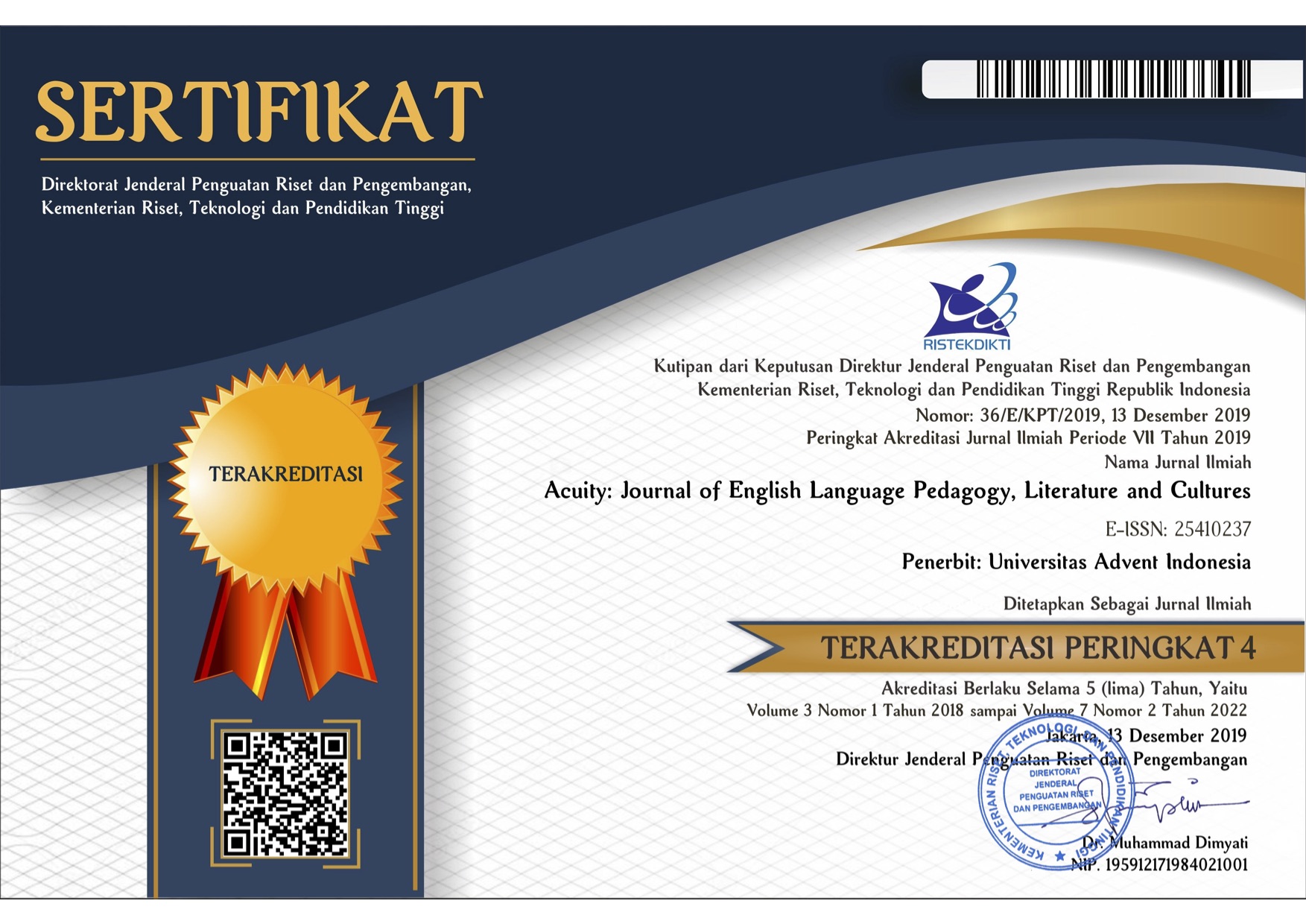ANALISIS PEMAHAMAN SISWA DALAM MENYELESAIKAN SOAL MATRIKS DITINJAU DARI SELF EFFICACYM MENYELESAIKAN SOAL MATRIKS DITINJAU DARI SELF EFFICACY
Kata Kunci:
matriks, pemahaman siswa, self efficacyAbstrak
Kemampuan pemahaman sangat berkaitan dengan keyakinan siswa dalam memahami suatu materi pelajaran. Jika siswa sudah memahami materi maka siswa akan yakin atau percaya diri untuk mengerjakan soal pada materi yang diberikan ataupun siswa bisa lebih mudah dalam melanjutkan ketahap selanjutnya. Tujuan penelitian ini yaitu untuk mengetahui pemahaman siswa yang memiliki self efficacy tinggi, sedang, dan rendah. Metode pengumpulan data yang digunakan adalah angket, tes soal serta wawancara. Instrumen yang digunakan berupa angket self efficacy, tes soal pemahaman siswa dan pedoman wawancara. Peneliti mengambil 6 subjek penelitian yaitu 2 siswa dengan keyakinan diri tinggi, 2 siswa dengan keyakinan diri sedang dan 2 siswa dengan keyakinan diri rendah. Penyajian data yang dilakukan adalah memaparkan hasil tes pemahaman siswa dan hasil wawancara siswa. Hasil penelitian menunjukkan bahwa tingkat self efficacy tinggi siswa mampu memenuhi semua indicator pemahaman. Siswa yang mempunyai self efficacy sedang hanya mampu memenuhi 5 indikator dari 7 indikator yang ada dan bisa mengerjakan 4 soal dari 5 soal yang diberikan. Untuk siswa yang mempunyai self efficacy rendah hanya mampu memenuhi 5 indikator dari 7 indikator yang ada dan hanya bias menjawab 3 soal dari 5 soal yang diberikan.
Unduhan
Referensi
Anggreini, D., Priyojadmiko, E., & Setiana, D. (2020). Analisis Koneksi Matematika
Ditinjau dari Tipe Kepribadian Sanguinis, Koleris, Melankolis, dan Plegmatis.
Buana Matematika: Jurnal Ilmiah Matematika dan Pendidikan Matematika,
(1), 71-88.
Tianingrum, R., & Sopiany, H. N. (2017). Analisis Kemampuan Pemahaman
Matematis Siswa.Prosiding Seminar Nasional Penelitian dan Pengabdian 20
–446.
Siliwangi, I. (2018). A Nalisis K Emampuan P Emahaman M Atematis S Iswa Smp
Pada Mosharafa : Jurnal Pendidikan Matematika Mosharafa : Jurnal
Pendidikan Matematika. 7, 251–262.
Fadmawarni, I. P., Maimunah, M., & Roza, Y. (2020). Analisis pemahaman
matematis pada materi bentuk aljabar dari aspek self efficacy siswa. Math
Didactic: Jurnal Pendidikan Matematika, 6(2), 183-197.
https://doi.org/10.33654/math.v6i2.955.
Utami, R. W., & Wutsqa, D. U. (2017). Analisis Kemampuan Pemecahan Masalah
Matematika dan Self efficacy Siswa SMP Negeri di Kabupaten Ciamis An
Analysis of Mathematics Problem-solving Ability a nd Self efficacy Students of
Junior High School in Ciamis Regency. 4(2), 166–175.
Zakiyah, S., Imania, S. H., Rahayu, G., & Hidayat, W. (2018). Analisis Kemampuan
Pemecahan Masalah dan Penalaran Matematik Serta Self efficacy Siswa Sma.
(4), 647–656.
Destinar, Jumaroh, S. M. D. (2019). Kemampuan Pemahaman Konsep Matematis
Ditinjau Dari Self Efficacy Siswa Dan Model Pembelajaran Think Pair Share
(TPS ) Di Smp Negeri 20 Palembang. 12(1), 115–128.
Somawati, S. (2018). Peran Efikasi Diri (Self Efficacy) terhadap Kemampuan
Pemecahan Masalah Matematika. 6(1), 39–45.
Fakhriatul Masnia, Zubaidah Amir (2019).Pengaruh Penerapan Model Scaffolding
terhadap Kemampuan Pemahaman Konsep Matematis Berdasarkan Self Efficacy
Siswa SMP. Juring (Journal for Research in Mathematics Learning).2(3).249-
Merdekawaty, A., Fatmawati, F., Samawa, U., & Besar, S. (2010). Pengaruh
Kemandirian Belajar Dan Efikasi Diri Terhadap Pemahaman Akuntansi Siswa.
https://doi.org/10.33603/ejpe.v7i2.1862.
Malito, J. (2018). Pengaruh Gaya Belajar, Kecerdasan Emosional, Self efficacy dan
Advertisy Quotient Terhadap Kemampuan Pemahaman Matematis Siswa. 1(1),
–80.
Bandura, A. (1997). Self efficacy: The Exercise of Control. W H Freeman/Times
Books/ Henry Holt & Co

##submission.downloads##
Diterbitkan
Cara Mengutip
Terbitan
Bagian
Lisensi
Hak Cipta (c) 2022 Jurnal Padegogik

Artikel ini berlisensiCreative Commons Attribution-NonCommercial-ShareAlike 4.0 International License.
Penulis yang mempublikasikan naskahnya di jurnal ini menyetujui hal-hal berikut:
- Hak cipta tetap pada penulis, penulis memberikan kepada jurnal hak penerbitan pertama dan sekaligus melisensi karyanya mengikuti Creative Commons Attribution License yang mengizinkan orang lain untuk berbagi karya dengan penghargaan terhadap hak kepenulisan dan penerbitan pertama di jurnal ini.
- Penulis bisa mengikuti kontrak tambahan lain untuk distribusi non-ekslusif bagi karyanya tersebut (contoh: mempostingnya ke repositori institusi atau menerbitkannya dalam sebuah buku), dengan penghargaan terhadap penerbitan pertama di jurnal ini.
- Penulis diizinkan dan didorong untuk mem-posting karya mereka online (contoh: di repositori institusi atau di website mereka) sebelum dan selama proses penyerahan, karena dapat mengarahkan ke pertukaran produktif, seperti halnya sitiran yang lebih awal dan lebih banyak dari karya yang diterbitkan. (Lihat The Effect of Open Access).







